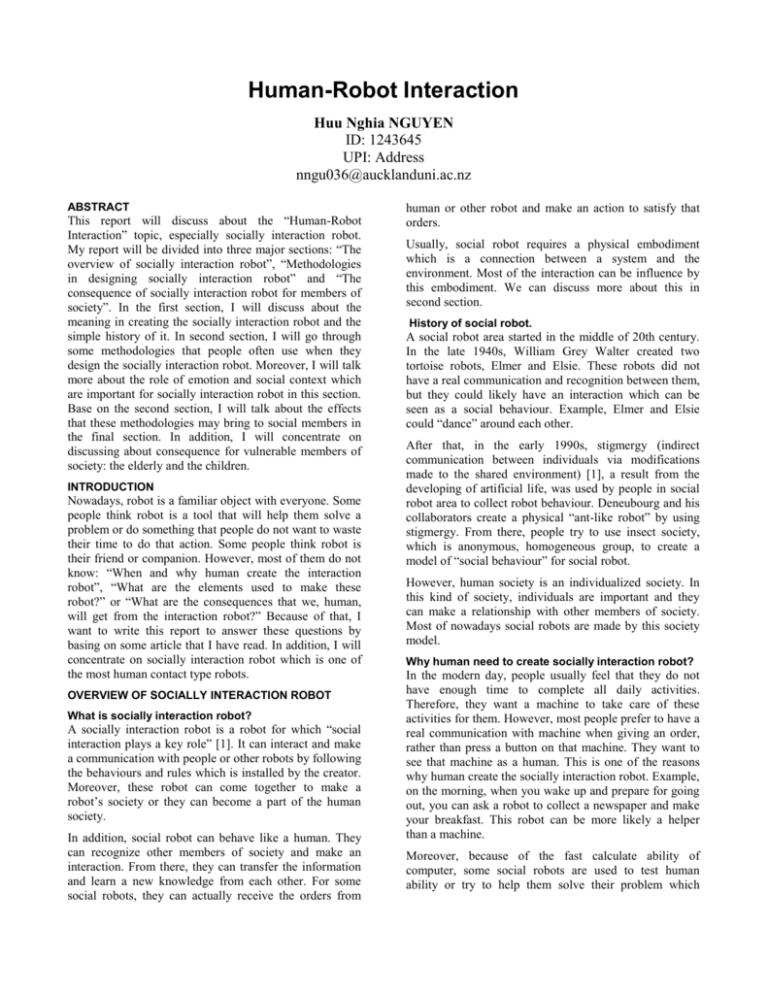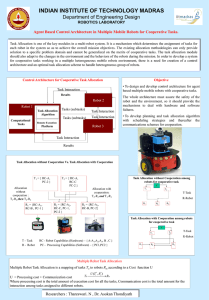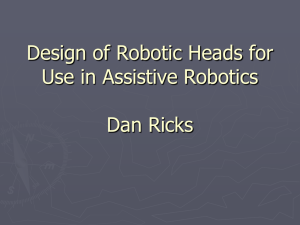nngu036
advertisement

Human-Robot Interaction Huu Nghia NGUYEN ID: 1243645 UPI: Address nngu036@aucklanduni.ac.nz ABSTRACT This report will discuss about the “Human-Robot Interaction” topic, especially socially interaction robot. My report will be divided into three major sections: “The overview of socially interaction robot”, “Methodologies in designing socially interaction robot” and “The consequence of socially interaction robot for members of society”. In the first section, I will discuss about the meaning in creating the socially interaction robot and the simple history of it. In second section, I will go through some methodologies that people often use when they design the socially interaction robot. Moreover, I will talk more about the role of emotion and social context which are important for socially interaction robot in this section. Base on the second section, I will talk about the effects that these methodologies may bring to social members in the final section. In addition, I will concentrate on discussing about consequence for vulnerable members of society: the elderly and the children. INTRODUCTION Nowadays, robot is a familiar object with everyone. Some people think robot is a tool that will help them solve a problem or do something that people do not want to waste their time to do that action. Some people think robot is their friend or companion. However, most of them do not know: “When and why human create the interaction robot”, “What are the elements used to make these robot?” or “What are the consequences that we, human, will get from the interaction robot?” Because of that, I want to write this report to answer these questions by basing on some article that I have read. In addition, I will concentrate on socially interaction robot which is one of the most human contact type robots. OVERVIEW OF SOCIALLY INTERACTION ROBOT What is socially interaction robot? A socially interaction robot is a robot for which “social interaction plays a key role” [1]. It can interact and make a communication with people or other robots by following the behaviours and rules which is installed by the creator. Moreover, these robot can come together to make a robot’s society or they can become a part of the human society. In addition, social robot can behave like a human. They can recognize other members of society and make an interaction. From there, they can transfer the information and learn a new knowledge from each other. For some social robots, they can actually receive the orders from human or other robot and make an action to satisfy that orders. Usually, social robot requires a physical embodiment which is a connection between a system and the environment. Most of the interaction can be influence by this embodiment. We can discuss more about this in second section. History of social robot. A social robot area started in the middle of 20th century. In the late 1940s, William Grey Walter created two tortoise robots, Elmer and Elsie. These robots did not have a real communication and recognition between them, but they could likely have an interaction which can be seen as a social behaviour. Example, Elmer and Elsie could “dance” around each other. After that, in the early 1990s, stigmergy (indirect communication between individuals via modifications made to the shared environment) [1], a result from the developing of artificial life, was used by people in social robot area to collect robot behaviour. Deneubourg and his collaborators create a physical “ant-like robot” by using stigmergy. From there, people try to use insect society, which is anonymous, homogeneous group, to create a model of “social behaviour” for social robot. However, human society is an individualized society. In this kind of society, individuals are important and they can make a relationship with other members of society. Most of nowadays social robots are made by this society model. Why human need to create socially interaction robot? In the modern day, people usually feel that they do not have enough time to complete all daily activities. Therefore, they want a machine to take care of these activities for them. However, most people prefer to have a real communication with machine when giving an order, rather than press a button on that machine. They want to see that machine as a human. This is one of the reasons why human create the socially interaction robot. Example, on the morning, when you wake up and prepare for going out, you can ask a robot to collect a newspaper and make your breakfast. This robot can be more likely a helper than a machine. Moreover, because of the fast calculate ability of computer, some social robots are used to test human ability or try to help them solve their problem which involve in calculation. Example, you can play chess with a robot by choosing the difficult level to test your ability in chess. In addition, with a large memory, you can ask a robot to remember a big data and make it remind you when you need that data. There are still more reasons why human want to create a social robot and most of them make human life better. METHODOLOGIES IN INTERACTION ROBOT DESIGNING SOCIALLY There are lot methodologies that we can use in designing socially interaction robot, but I choose eight of them to discuss in this section. I choose these methodologies because all of them are used to make the social robots become human-like which is the main point of my report. In this section, I will go through each of these methodologies and discuss how they improve the humanrobot interaction. Embodiment Embodiment is a key element in the relationship between system and environment. It helps the robot perturb an environment or be perturbed by it. Perturbation can be used when we want to compare the embodiment of two or more robots. Moreover, we know that a physical appearance has a big effect in human-robot interaction. We cannot treat a doglike robot as same as human-like robot. The robot appearance can be decided by the purpose of the robot. When you make a robot for communication with human, it will make people who interact with the robot more comfortable if that robot is made in human form. When making robot for playing with children, we usually choose a form of animal or pet for that robot instead of human form. Because of that, embodiment is divided into four categories: Anthropomorphic: This kind of robot will have an appearance similar with human. It will make an illusion that anthropomorphic robot is a human. Moreover, this kind of robot can have an ability of performing human action. Zoomorphic: In this category, robots will be made in form of pet or animal. People often use these robots for playing with children or using in education. Caricatured: Caricatured robots can look like an animator characters which do not have realistic appearance. Because of that, these robots can be used to get more attention of other people. Functional: These robots are made to satisfy its function. They will be maximised function capacity by having a physical body which reflects the task. Emotion We all know emotion is one of important elements in human interaction. If we need to improve the human- robot interaction, emotion plays a key role. Most of the robots express their emotion by changing their appearance or making an action. With a dog-like robot, when we touch its head, it expresses happiness by moving its head and tail. With a human-like robot that displays a human face, expressing an emotion is changing the face that fit for the emotion. Speech is a usual way to communicate in human interaction. Therefore, most people want to use speech when they give the order to robots because they prefer to see robots as human being. On the other hand, speech can use to express an emotion by changing some elements of speech. These elements are loudness, pitch and prosody. By modifying these, we can let the robots express different emotion when they communicate with human. For example, when human ask a robot an annoying question, it can have louder voice and high pitch for expressing their angry. When using speech to express an emotion is verbal, expressing an emotion by facial expression and body language is non-verbal. They just use the changing of physical appearance to achieve the emotion that they want. In addition, we usually use a screen which displays a face or mechanical actuation for robots with these functions. Base on [4] study, using a combination of verbal content and facial expression when robots express an emotion is congruence for improving the human-robot interaction. Dialogue Dialogue is used by human when transferring or sharing information between members in soceity. Robots that have dialogue function can have a long conversation with users. Through the dialogue, robots can collect the information from the users and use that to improve the conversation between them by making a suitable reply. In addition, information from dialogue can be transferred into a data form that will be stored for later use. For example, a robot in hospital can have a dialogue with patients and collect the data that a doctor can use to help that patient. In human-robot interaction, we can divide dialogue into three types: Low-level: With low-level type, robots can get information by the robot sensor-actuator sate space. Non-verbal: Robots can use body position, gesture and physical action to express what they want to say. This can be combined with speech to make a conversation more understandable. More than that, this type can be applied when robots have an interaction with deaf people. Natural language: This type depends on many factors which we still cannot teach robots. Because of that, natural language type still be considered as an open issue. Personality Socially situated learning “Personality is the set of distinctive qualities that distinguish individuals”. This is a definition of personality in psychological term. From there, we can understand that everyone has their unique personality and it makes one person different form other people. Give robots a personality is one way to make human-robot interaction better. People will easier make a relationship with robots if those robots which they interact with have personality. Social robots learn by collecting skills, tasks and information. After that, the robots transfer this information into the data that they can understand. The more data the social robots understand, the more improvement they will make. In recent years, when people try to know how social learning can be affected by human-robot interaction, they discovered two approaches. One of them is to use known behaviours to teach the social robots a human model. Another is to observe and understand behaviours. With an ability of human today, we cannot make each robot has difference personality. Therefore, we divide robots into five groups. Each group will be applied with same type of ability. This division can base on robot’s function or user’s requirement. Those five types are: toollike, creature, cartoon, artificial being and human-like. In addition, emotion, embodiment and communication can become factors that contribute in conveying robot personality. Human-oriented perception Perceiving the world as human do is a requirement which social robot need to achieve if they want to have a meaningful interaction. The robot needs to have an ability to track human features. However, the problem of the presence of occlusions, variable illumination, moving cameras and varying background need to be solved first. Besides that, speech recognition is an element of perception, too. Usually, robot requires some of these elements: Who the speaker is, what the speaker said and how the speaker said it. Based on what the robot wants, that robot will be installed with different function. In addition, human can use gesture in speech to make that speech more understandable. If a robot wants to have correct information from the interaction, it will need gesture recognition. Moreover, human have an emotion and it can affect the quality of the interaction. Therefore, the robot need to be able to detect and recognize human facial expression which will help the robot performs a correct action in that interaction. User modelling To make social robots become more likely human, we can make it interact in a human-like manner. To achieve this, the robots need to know about human social behaviour. By using user modelling, the robots can interpret and react to that behaviour. In the user model, there are attributes which describe a user, or group, of users. This information can be collected explicitly or implicitly. After having that information, we can use it to help the robot understand human behaviour. Moreover, user model can make some benefits for users. They can get a control feedback from this user model. The method that people often use to teach social robots is imitation. With this method, we make the robots copy the actions from another being. Although the social robots can imitate these actions, there are some problems that we need to consider. Firstly, what are the time and the action that the robots are allowed to imitate? Secondly, the social robots need to know how to map the action into the behaviour. Finally, the robots need to be able to evaluate the error of behaviour before learning it. Solving these problems, we can use imitation in the robots’ social learning. Intentionality Most of the human’s actions are the result of the intention. If we want to make the social robots interact socially, we need to make them provide the intention of their action. On way to do that is an attention which is a fundamental requirement for intentionality. The social robots need to identify all the objects that will be relevant to their action. After that, the social robots need to “look” at the object by sensors and remain the focus on that object until they finish their relevant action. For example, when a robot wants to pick a newspaper on the ground, it needs to “look” at that newspaper before get it. When a robot interacts with a group of people, it needs to “look” at the person that it will talk with. Expression can be used to provide an evidence of intention, too. Before the social robots make an action, they can use facial expression to show people their intention. THE CONSEQUENCE OF SOCIALLY INTERACTION ROBOT FOR MEMBERS OF HUMAN SOCIETY From the second section, we can see that most methodologies try to make a human illusion for social robots. This illusion will make people see these robots as human or members of society. The interaction between us, human, and these social robots will make some consequences which we need to consider. As we know, human always search for another being that can behaviour like us. This action can be a result of the loneliness. When searching, we create the social robots and try to make it become human-like being. The interaction between human and robot can be a small solution for that loneliness problem. This can be a positive consequence that we get from this interaction. However, some of us go too deep in the relationship with the social robots and we do not see these robots as a machine anymore. This can be a negative consequence because it can make some people stopping from interacting with real human. On the other hand, we know from the first section that human nowadays do not have enough time to complete all activities that they want. Therefore, we have a social robots help us complete these activities. A social robot with good design for human-robot interaction can make the cooperation between the users and the robots better, because the users do not have any delay or difficulty in asking the social robots help them to complete the task. Moreover, we can say that robots will not feel tired after working for a long time, so they can spend more on finish the task that they was asked for. However, this can be related to the fact that some people will lose their job because of social robots. We may do not see that problem at this time, but we can consider about it for the future. Although most people in the society have knowledge about social robots, there are few members of society that do not know about that. What are the consequences that they will get when they interact with the social robots which give an illusion that they are human? Consequence for the elderly When the elderly interact with social robots, they will think that they form a relationship with them. This problem can increase their level of anxiety because they think they need to look after the robots. However, this relationship can reduce their loneliness but it can reduce the level of social interact, too. The elderly will have less contact with other human in the society because they have social robots with them. Then they will depend too much on social robots. Besides that, there is one positive consequence for having social robots with the elderly is that the social robots can bring some health benefit for the elderly who mostly need it. Consequence for children When the elderly still has some positive consequences, most of the consequences for the children are negative. We need to know that the children are who do not know about robots until they learn it. So the interaction between the children and the social robots can impede the development of children’s understanding of how to interact with fellow human being. Because of that, children cannot learn how to take another’s perspective. Moreover, they cannot learn the give and take of human relationship. Moreover, the more interaction they have with social robots, the more reduction they will have in language development and cognitive development. Social robots still have a limitation in teaching area when the children are who need to have the best teacher to teach them. CONCLUSION As we know, the socially interaction robot area is young when comparing with other area. This area can still develop further in the future. So the limitation on technology or methodology is acceptable. However, these methodologies that we have now still can make a big improvement in human-robot interaction. In addition, we need to consider about the consequences when using socially interaction in society. We can see that there are both positive and negative consequences, but the impact of these negative consequences is not small. Therefore, the reduction of negative consequence need to be considers when we design the social robots. REFERENCES [1] Fong, T., Nourbakhsh, I. and Dautenhahn, K. A survey of socially interactive robots. Robotics and Autonomous Systems, 42, 3–4 (3/31 2003), 143-166. DOI=10.1016/S0921-8890(02)00372-X. [2] Kahn, P. H., Freier, N. G., Kanda, T., Ishiguro, H., Ruckert, J. H., Severson, R. L. and Kane, S. K. Design patterns for sociality in human-robot interaction. In Anonymous Human-Robot Interaction (HRI), 2008 3rd ACM/IEEE International Conference on. (). , 2008, 97104. [3] Kaniarasu, P., Steinfeld, A., Desai, M. and Yanco, H. Robot confidence and trust alignment. In Anonymous Human-Robot Interaction (HRI), 2013 8th ACM/IEEE International Conference on. (). , 2013, 155-156. [4] Malchus, K., Stenneken, P., Jaecks, P., Meyer, C., Damm, O. and Wrede, B. The role of emotional congruence in human-robot interaction. In Anonymous Human-Robot Interaction (HRI), 2013 8th ACM/IEEE International Conference on. (). , 2013, 191-192. [5] Qianli Xu, Ng, J., Cheong, Y. L., Tan, O., Wong, J. B., Tay, T. C. and Park, T. The role of social context in human-robot interaction. In Anonymous Network of Ergonomics Societies Conference (SEANES), 2012 Southeast Asian. (). , 2012, 1-5. [6] Sabanovic, S., Michalowski, M. P. and Simmons, R. Robots in the wild: observing human-robot social interaction outside the lab. In Anonymous Advanced Motion Control, 2006. 9th IEEE International Workshop on. (). , 2006, 596-601. [7] Salter, T., Michaud, F. and Letourneau, D. What are the benefits of adaptation when applied in the domain of child-robot interaction? In Anonymous Human-Robot Interaction (HRI), 2009 4th ACM/IEEE International Conference on. (). , 2009, 237-238. [8] Schmidt, C. T. Socially interactive robots. Why our current beliefs about them still work. In Anonymous Robot and Human Interactive Communication, 2002. Proceedings. 11th IEEE International Workshop on. (). , 2002, 560-564. [9] Sharkey, A. and Sharkey, N. Children, the Elderly, and Interactive Robots. Robotics & Automation Magazine, IEEE, 18, 1 ( 2011), 32-38. DOI=10.1109/MRA.2010.940151.



